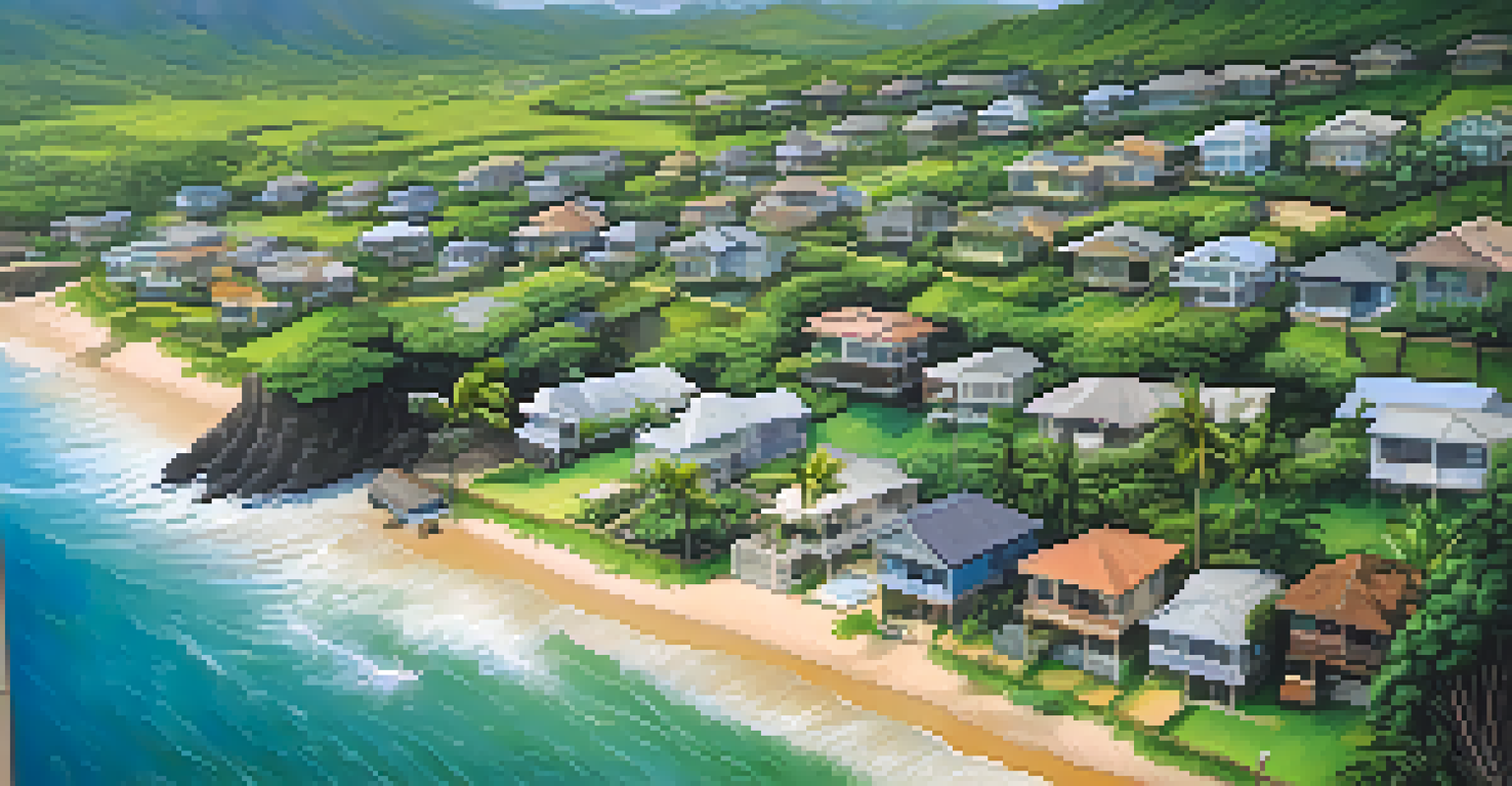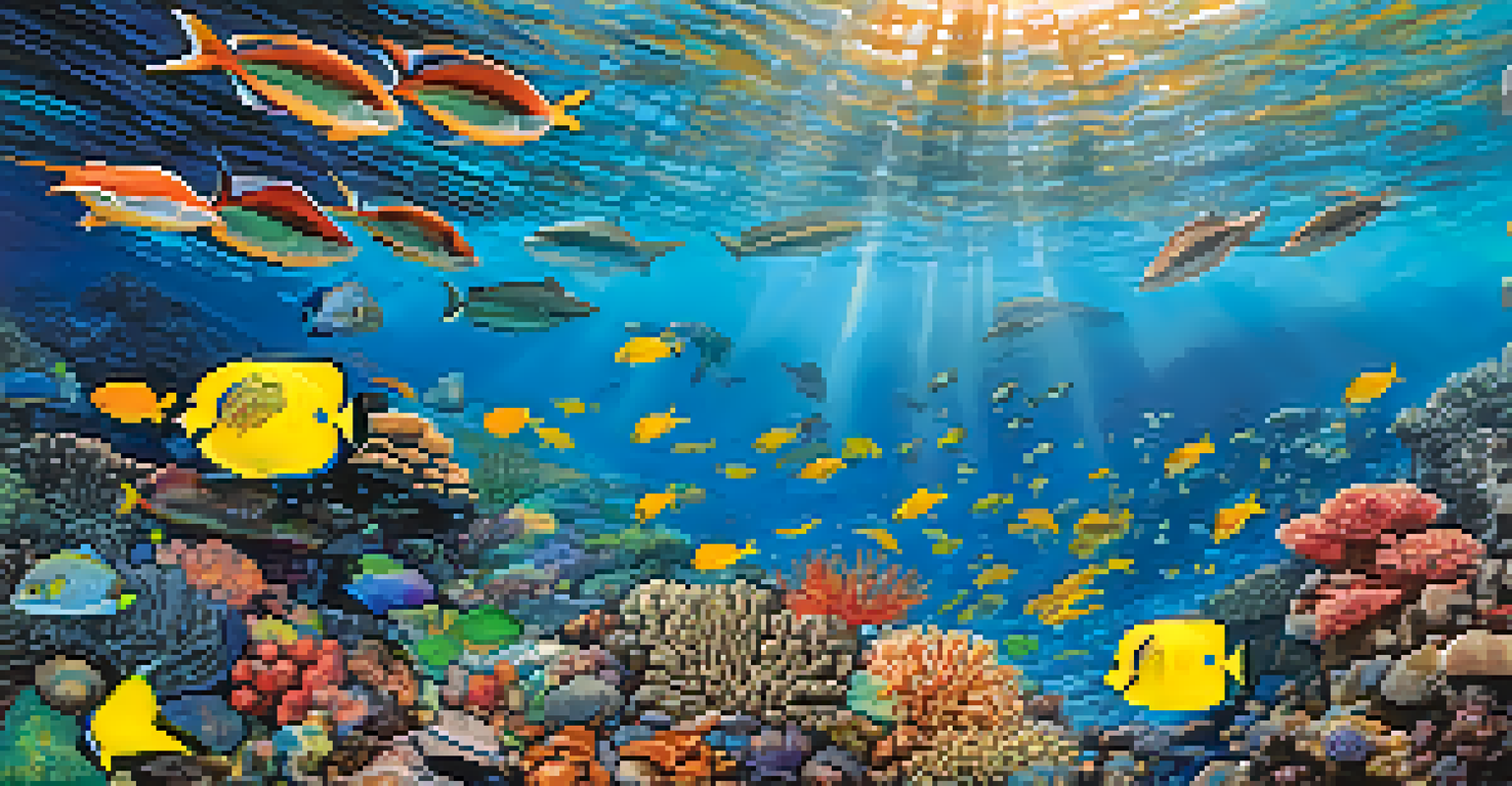The Rising Sea Levels in Hawaii: A Climate Change Overview

Understanding Sea Level Rise and Its Causes
Sea level rise is one of the most pressing issues caused by climate change. It primarily occurs due to two factors: the melting of glaciers and polar ice caps, and the expansion of seawater as it warms. In Hawaii, these rising waters pose a significant threat, impacting both the natural landscape and human habitation.
Climate change is no longer some far-off problem; it is happening here, it is happening now.
As global temperatures rise, glaciers in Greenland and Antarctica melt at alarming rates, contributing to rising sea levels. Additionally, warmer ocean waters expand, further exacerbating the problem. This combination spells trouble for coastal regions, especially for islands like Hawaii, where land is just a few feet above sea level.
Understanding these causes is crucial for grasping the urgency of the situation. By recognizing how human activities, such as greenhouse gas emissions, contribute to climate change, we can better appreciate the need for immediate action to mitigate these impacts.
The Current State of Sea Levels in Hawaii
Hawaii has already experienced a noticeable increase in sea levels, with rates exceeding the global average. Data from the National Oceanic and Atmospheric Administration (NOAA) indicates that sea levels around the islands have risen about 1.5 inches per decade over the past century. This may not sound like much, but it translates to significant changes in the coastal ecosystem.

Communities along the shoreline are beginning to feel the effects of this rise, as erosion and flooding become more frequent. Places like Waikiki have seen increased beach erosion, affecting tourism and local businesses. The local government has started to implement measures to adapt, but challenges remain as the sea continues to encroach.
Sea Level Rise Threatens Hawaii
Rising sea levels, primarily due to ice melting and ocean warming, pose significant risks to Hawaii's landscapes and communities.
Moreover, rising sea levels threaten freshwater resources by allowing saltwater to intrude into groundwater supplies. This can affect agriculture, drinking water, and the overall health of ecosystems that depend on freshwater sources.
Impact on Hawaii's Ecosystem and Biodiversity
Hawaii is home to unique ecosystems and species found nowhere else on Earth. Unfortunately, rising sea levels threaten these habitats, particularly coastal wetlands and coral reefs. Wetlands serve as vital buffers against storms and provide habitat for numerous species, while coral reefs protect shorelines and support marine life.
We won’t have a society if we destroy the environment.
As sea levels rise, these ecosystems face risks from increased salinity and habitat loss. For example, sea turtles and monk seals, both native to Hawaii, rely on sandy beaches for nesting. As those beaches disappear, their populations face greater challenges in survival.
Additionally, coral reefs are particularly vulnerable to climate change and sea level rise. With warmer water temperatures leading to coral bleaching, the combined stresses of rising seas and temperature can decimate these vital habitats, affecting both marine biodiversity and local fishing communities.
Social and Economic Impacts on Local Communities
The rising sea levels in Hawaii are not just an environmental concern; they also present significant social and economic challenges for local communities. Many coastal residents may face displacement, leading to a loss of homes and cultural heritage. This is particularly critical for Native Hawaiian communities, whose connection to the land is deeply rooted in their history.
Economically, tourism, a major driver of Hawaii's economy, could suffer as coastal areas become less accessible or even uninhabitable. Tourists flock to Hawaii for its stunning beaches and lush landscapes, and any degradation of these natural attractions could lead to declines in visitor numbers, impacting local businesses.
Ecosystems at Risk from Rising Seas
Unique ecosystems in Hawaii, including coral reefs and coastal wetlands, are threatened by increasing salinity and habitat loss due to rising sea levels.
Furthermore, the cost of implementing adaptation measures, such as building sea walls or relocating infrastructure, can strain local budgets. It's essential for all stakeholders to work together to address these challenges and develop sustainable solutions that protect both the environment and the economy.
Government Response and Climate Action Initiatives
In response to the rising sea levels and the broader challenges of climate change, the Hawaiian government has initiated several programs aimed at mitigation and adaptation. These efforts include updating building codes, investing in coastal restoration projects, and promoting sustainable land use practices.
One notable initiative is the Hawaii Climate Change Mitigation and Adaptation Commission, which aims to coordinate state and county efforts to address climate impacts. This commission works to develop strategies that prioritize resilience and sustainability, ensuring that Hawaii can adapt to changing conditions.
Community engagement is also a vital aspect of these initiatives. By involving local residents in decision-making processes, the government can create more effective and culturally relevant strategies. This collaboration helps build a sense of ownership and responsibility towards protecting Hawaii's unique environment.
Community Adaptation Strategies for Resilience
Community resilience is key to adapting to rising sea levels in Hawaii. Local organizations and residents are actively developing strategies to protect their homes and environments. For instance, some communities are exploring natural solutions, such as restoring mangroves and wetlands, which can absorb storm surges and minimize flooding.
Education and awareness are also crucial components of community adaptation. Programs that inform residents about the risks associated with sea level rise can empower them to take action. Workshops and local initiatives can guide homeowners on how to elevate their properties or create rain gardens to manage stormwater effectively.
Community Resilience is Key
Local organizations and residents are developing strategies, such as restoring wetlands and increasing awareness, to adapt to the challenges posed by rising sea levels.
Additionally, community-led efforts to advocate for policy changes can amplify local voices in the broader conversation about climate action. By uniting to push for sustainable practices, residents can play a significant role in shaping a more resilient future for Hawaii.
Looking Ahead: The Future of Hawaii Amid Rising Seas
The future of Hawaii in the face of rising sea levels is uncertain, but there is hope through proactive measures and community engagement. Scientists predict that if current trends continue, sea levels could rise by several feet by the end of the century. This means that immediate action is essential to mitigate these impacts and protect both the environment and local populations.
Innovative solutions, such as managed retreat and smarter urban planning, are being explored to adapt to these changes. These approaches involve relocating critical infrastructure away from vulnerable areas and developing new policies that encourage sustainable land use in coastal regions.

Ultimately, the key to a resilient future lies in collective action. By prioritizing climate change adaptation and fostering a culture of sustainability, Hawaii can continue to thrive despite the challenges posed by rising sea levels. The spirit of 'Aloha' can guide both residents and policymakers alike in creating a sustainable future for the islands.